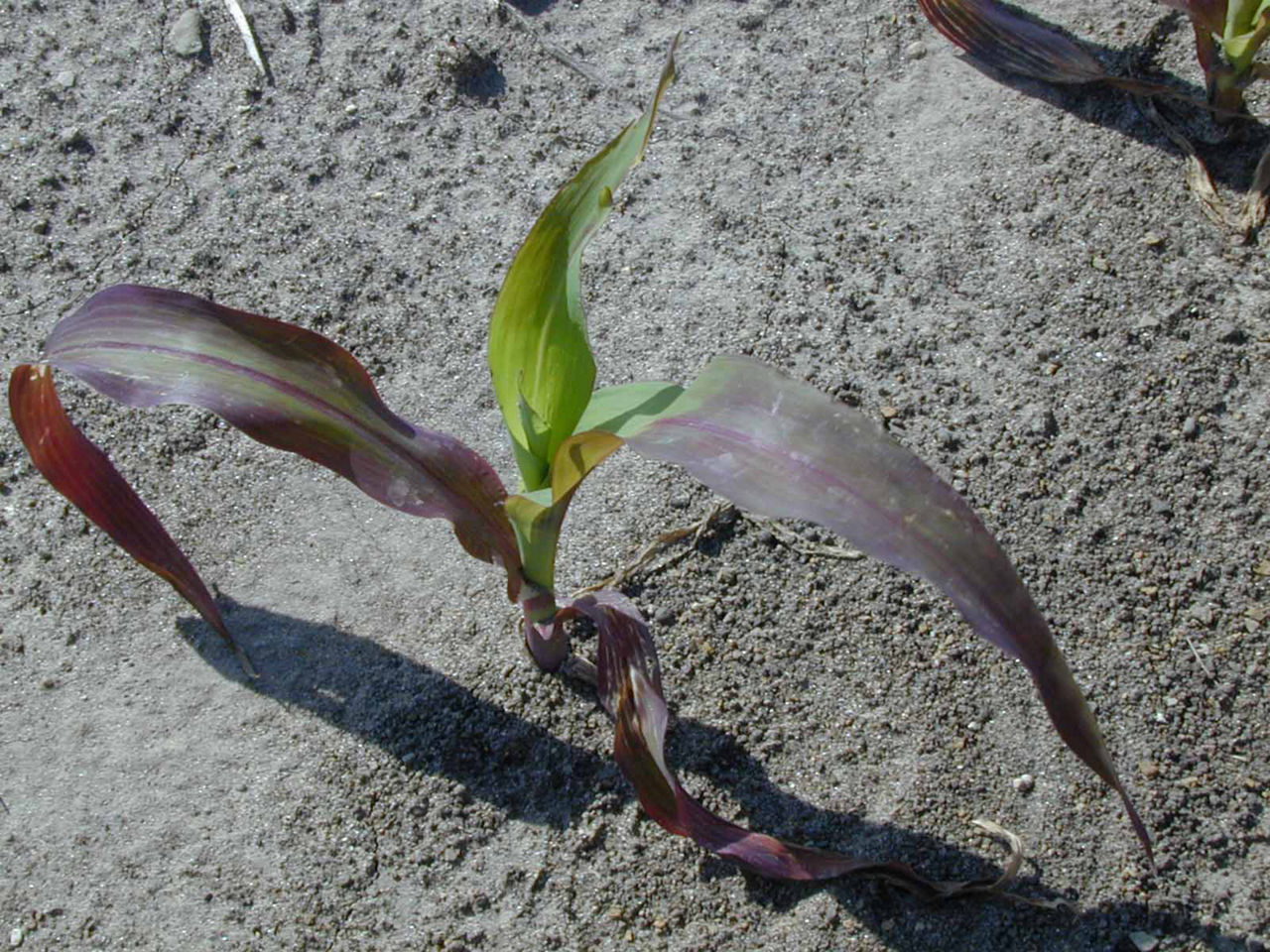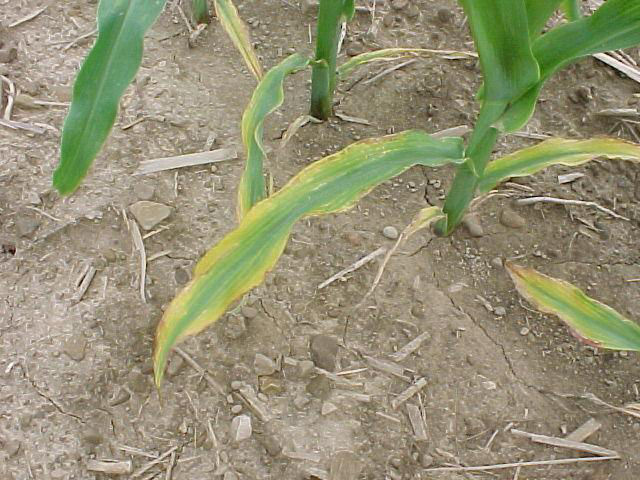3 MIN READ
Importance of Phosphorus and Potassium in Corn Development
April 18, 2024
Introduction
- Phosphorus (P) and potassium (K) are two of the twelve essential nutrients for plant growth.
- Both P and K are absorbed in large quantities by corn plants.
- Phosphorus is important for stimulating root and shoot growth and promoting vigorous seedling growth.
- Potassium helps increase disease resistance and water stress tolerance. Adequate K increases the ability of corn plants to efficiently uptake other nutrients.
- Soil test results and determining the rate at which a removes P and K from the soil can help guide fertility management decisions.
Phosphorus Availability
Phosphorus in the soil is an “immobile nutrient”, meaning it has a relatively short range of movement in the soil over time, and its availability to plants is influenced by chemical and environmental factors. Most of the P in the soil is tied up chemically in a form that is unavailable to a crop in any given growing season. Indeed, the amount of P available to plants is very low compared to the total amount of P in the soil. For example, total soil phosphorus may exceed 800 to 1,000 pounds per acre (896 to 1120 kg per hectare), but the plant available P might only be 0.04 to 0.13 pounds per acre (0.4 to 0.15 kg per hectare). The temperature of the soil and the amount of soil moisture can also influence the availability of soil P and its rate of uptake by plants. Dry soil conditions can negatively impact uptake by the root system.
As a crop removes the available P, the soil releases more chemically available P into the soil solution. Plants become P deficient when they require more P than the soil can release. Soil tests do not report total P in the soil, given that most of that P is unavailable, but instead predict if the soil will be able to release enough bioavailable P during the growing season to keep up with the projected yield goal. Fertilization is often recommended when soil tests indicate that adding P could help increase yield potential.
Manure is an excellent source of slow-release, organic P that can be broken down by microbes into plant-available forms. However, the amount of bioavailable in manure can vary depending on several important factors, such as:
- Diet of the animal
- Animal species
- Handling and storage of manure
- Type and amount of bedding material
Role of Phosphorus in Plant Development
Plants require phosphorus to grow throughout their life cycle, especially during the early stages of development. Phosphorus is integral to photosynthesis, which plants need in order to synthesize sugars, starches, and proteins.1 Adequate P levels are particularly important during the early to enhance shoot and root growth, and to increase water use efficiency and yield potential. When P levels are too low, corn cannot grow, produce, or tolerate stress.
Cold Temperature-Induced Phosphorus Deficiency Symptoms
Early season phosphorus deficiency symptoms can occur in plants with low soil temperatures, even if adequate P is present. Low soil temperatures limit root growth and nutrient uptake, resulting in a temporary P deficiency that may cause plants to be stunted or purple in color (Figure 1). The purple coloration is caused by the accumulation of reddish-purple anthocyanin pigments. Symptoms diminish as the soil warms up.3
However, P deficiency is not the only thing that can cause corn seedlings to turn purple. This color can also be caused by a combination of bright, sunny days and cool nights (40s to 50s °F, 4 to 10’s °C) during the V3 to V6 stages which cause high photosynthetic activity during the day and little metabolism during the night, resulting in an accumulation of the anthocyanin pigments.2 This condition will not impact yield, unlike a P deficiency. Some corn products also have a natural, genetic purple seedling color that can be mistaken for cold weather-induced P deficiency. This purple coloration can be observed on some corn products during all stages of plant development.

Phosphorus Uptake During Critical Growth Stages
Corn plants increase phosphorus uptake rapidly after the V6 growth stage (six visible leaf collars), which is about four to six weeks after planting. Phosphorus uptake continues until near maturity. Mid- to late-season P uptake will be directed toward reproduction. Symptoms of P deficiency on older corn include stunted plants and yellowing of the leaf margins of older leaves. In addition, P-deficient stalks may be thin and short, and maturity can be delayed. Soil testing or tissue testing for P levels can help confirm deficiency.
Important Potassium Soil Characteristics
Like P, most of the potassium (K) in the soil is not readily available to plants. The total amount of K in soil ranges from 5 to 25 tons per acre,4 but almost all K is chemically bound to the soil. The amount of bioavailable K supplied by soils varies during the growing season. Fields with compacted soil, dry soil, very light soil, or sandy soil are more likely to cause K deficiency symptoms in plants, as are fields in which certain conservation tillage practices are used that do not apply subsurface K.
Role of Potassium in Plant Development
Potassium is associated with the movement of water, nutrients, and carbohydrates within the plant. These functions stimulate early growth, increase protein production, improve the efficiency of water use, and increase resistance to diseases and insects. Plants with insufficient K have difficulty absorbing water and N from the soil, which might increase drought stress. Corn plants conserve water and reduce moisture stress by closing leaf stomata (openings on the undersides of leaves), a process that requires K. Additionally, K deficient plants may have a reduced photosynthetic capacity.
Role of Potassium in Stalk Rot Disease
Stalk rots are among the most common and damaging of the corn diseases, potentially causing yield losses from premature plant death and lodging. Balancing K and nitrogen (N) levels in plant tissues can help improve plants’ resiliency to stalk rot. Plants with too much N can grow too rapidly, producing weaker tissue that is more vulnerable to stalk rot, while plants with the proper levels and ratio of K to N may produce structurally stronger growth that is more resistant. Adequate K can also moderate stalk dry down after maturity and reduce the risk of lodging.

Potassium Uptake During Critical Growth Stages
Potassium uptake by corn increases rapidly around the V6 growth stage, approximately four to six weeks after planting. Potassium uptake is completed soon after silking (R1 stage). When K demand becomes large and there is not enough available K, deficiency symptoms may become visible. Potassium deficiency symptoms first appear on the lower leaves in corn because K is easily moved within the plant from older to younger leaves. Leaf symptoms are a yellowing to necrosis (tissue death) of the outer leaf margins (Figure 2). These symptoms begin at the leaf tip and progress down the margin toward the leaf base. Symptomatic leaves often die during hot, dry, and windy conditions when K deficiency is severe.5 Plants lacking K may have shortened internodes, weak stalks, excessive lodging, and increased leaf and stalk disease. They may also have a lighter green color when viewed from a distance.
Managing Phosphorus and Potassium
Understanding both crop nutrient uptake and removal can help producers better match plant nutritional needs to reach a target yield goal. The soil fertility levels for P and K are greatly impacted by their availability in the soil and by previous crop removal. Each bushel of corn harvested per acre removes approximately 0.35 pounds per acre (0.39 kg per hectare) of P2O5 and 0.20 pounds per acre (0.22 kg per hectare) of K2O. Corn harvested for silage—or if the stalks are otherwise removed after harvest—removes significantly more: approximately 2.54 pounds per acre (2.84 kg per hectare) of P2O5 and 8.2 pounds per acre (9.1 kg per hectare) of K2O per ton of corn.
Soil fertility tests should be conducted at least every other year to verify that appropriate fertility levels are maintained. If there is concern about fertility, especially due to very high or very low yields, yearly soil tests can aid with fertility decisions. It is important to apply fertilizers based on the values of the soil test. When soil test levels are in the high range, P and K fertilizer application may not be needed. When test levels are in the optimum range, an application rate equal to the amount of nutrients removed at harvest is recommended. Always consider residual fertility from previous crops and manure applications when determining fertilizer application amounts. It is very difficult to raise soil test levels if soil test levels are very low, and soil test levels can only be increased if nutrient application rates exceed the crop removal rate. In general, 20 pounds (9 kg) of P2O5 and 6 to 10 pounds (2.7 to 4.5 kg) of K2O above crop removal are required to raise soil test levels one part per million for P and K, respectively.6 The actual amount of each nutrient needed depends on the initial soil test level, yield level, soil texture, clay minerals, and organic matter levels.
Sources
1Chakraborty, D. and Prasad, R. 2019. Phosphorus basics: Deficiency symptoms, sufficiency ranges, and common sources. Alabama Cooperative Extension, ANR-2588. https://www.aces.edu/blog/topics/crop-production/phosphorus-basics-deficiency-symptoms-sufficiency-ranges-and-common-sources/
2Nielsen, R.L. 2022. Prevalent purple plants perennially puzzle producers. Purdue University Extension. https://www.agry.purdue.edu/ext/corn/news/timeless/PurpleCorn.html
3Oldham, L. 2015. Phosphorus in Mississippi soils. Mississippi State University Cooperative Extension Service, P3961. http://extension.msstate.edu/publications/phosphorus-mississippi-soils
4Oldham, L. and Jones, K. 2020. Potassium in Mississippi soils. Mississippi State University Cooperative Extension Service, P3962. http://extension.msstate.edu/publications/potassium-mississippi-soils-0
5Sayer, J. 2000. Potassium deficiency symptoms in corn. Iowa State University of Science and Technology. https://crops.extension.iastate.edu/encyclopedia/potassium-deficiency-symptoms-corn
6LaBarge, G. 2012. How much fertilizer does it take to move soil test levels? Ohio State University Extension. https://ocj.com/2012/11/how-much-fertilizer-does-it-take-to-move-soil-test-levels/#:~:text=The%20buildup%20equations%20in%20the,depending%20upon%20the%20soil%20CEC.
1213_102861